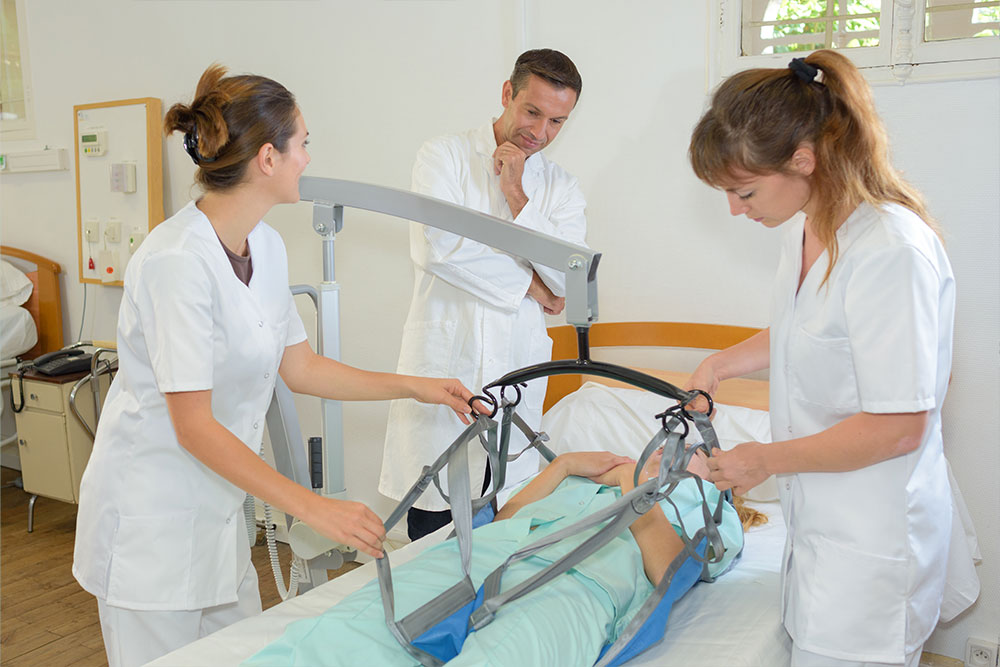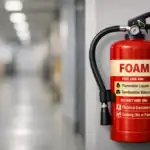
Moving objects can be dangerous. Moving people more so. Both the lifter and the person being moved are at risk of injury. And any movement must be planned and executed in a way that protects the patient’s dignity and humanity. So, what are the three main considerations for moving and handling people?
This blog explains what you need to do to make moving and handling safe for yourself and your patients. It also highlights the regulations you need to comply with, including the three-part framework all moving and handling work must follow.
Moving and Handling vs. Manual Handling
As a healthcare professional, you’ve probably encountered the terms ‘moving and handling’ and ‘manual handling.’ Some people confuse the two or use them interchangeably, but they refer to two distinct concepts.
Moving and Handling is the physical movement of patients or service users by bodily force within a care setting. This includes tasks like helping patients out of bed, assisting them to the bathroom or transferring them from a wheelchair to a chair. The primary focus here is on the safe and respectful handling of individuals needing support due to mobility issues, illness or disability.
Manual Handling involves physically lifting, carrying or moving inanimate objects, such as boxes or equipment. While the principles of safe manual handling and moving and handling are similar for the lifter, there’s obviously no need to move the objects with compassion or dignity.
Historically, the term ‘manual handling’ was used to describe the movement of both objects and people. This overlap explains why some people still refer to the movement of people as manual handling.
The confusion isn’t helped by the fact that regulations group moving and handling patients with traditional manual handling operations. In the UK, the Manual Handling Operations Regulations 1992 apply to both moving loads and moving people. This means that the same rules are in place whether you’re lifting a patient or a box.
Legal Requirements for Moving and Handling
The Manual Handling Operations Regulations (MHOR) outline three key considerations for managing moving and handling tasks safely:
- Avoid moving and handling if at all possible.
- Risk assess moving and handling tasks that can’t be avoided.
- Implement control measures to make moving and handling safe.
Moving and Handling of People Training
This Moving and Handling of People Training course provides comprehensive guidance for care sector workers. It covers the legal requirements, injury risks and best practices for moving and handling people in healthcare settings.
What are the Three Main Considerations for Moving and Handling?
This section answers the question, “What are the three main considerations for moving and handling?” and explains how to comply with MHOR’s three-part framework.
1. Avoid Moving and Handling Where Possible
The only way to eliminate injury risks entirely is to avoid moving and handling altogether. You can do this in two ways:
- Redesigning tasks
- Using equipment
Redesigning Tasks: Review current workflows and look for opportunities to redesign tasks to avoid moving and handling. For example, transporting equipment to the patient rather than vice versa.
Using Equipment: Using equipment is probably a more realistic solution than redesigning tasks. Adjustable beds and chairs can make transfers more manageable and reduce the physical effort needed to move patients. Mobile hoists are also commonly used to eliminate the need to lift patients via bodily force completely.

2. Carry Out a Risk Assessment
When moving and handling are unavoidable, a competent person must conduct a risk assessment of the planned work. This process identifies potential hazards and evaluates risks, letting you implement the necessary precautions.
There are two forms of manual handling risk assessments:
- Generic manual handling risk assessments
- Individual manual handling risk assessments
Generic risk assessments consider factors like the types and frequencies of tasks, necessary equipment and the physical environment.
Individual risk assessments are tailored to the specific needs of the patient or service user. They determine the level of assistance required and the number of staff needed for safe handling.
Both risk assessment types follow the same process. Someone with a sufficient level of knowledge, experience and training (i.e. a competent person) acts to:
- Identify Hazards: Recognise potential dangers of moving and handling tasks.
- Assess Risks: Evaluate the likelihood and severity of harm these hazards may cause patients and staff.
- Implement Controls: Put measures in place to minimise or eliminate identified risks, such as using hoists or providing training.
- Record Findings: Document the hazards, risks and the implemented control measures for accountability and compliance.
- Review and Update: Regularly revisit and revise the risk assessments and controls to reflect any changes in the workplace, procedures or patient needs.
3. Implement Controls that Make Moving and Handling Safe
This final consideration is a continuation of the risk assessment process. After identifying hazards and assessing the risks, the next step is implementing controls that ensure moving and handling tasks are as safe as possible.
The controls you use depend on your workplace and the parties involved, but we’ve covered some common ways you can make moving and handling safer below:
- Use Appropriate Equipment: Mechanical aids such as hoists, transfer boards and sliding sheets reduce the physical strain on staff and support safer handling of patients and service users.
- Maintain Equipment Regularly: If equipment is used to lift people, it must be routinely inspected and maintained by competent people to ensure it’s in safe working condition. Workers should also conduct pre-use checks and flag any issues immediately.
- Adjust the Environment: Modify the workspace to allow safe handling practices. Create enough space for workers to manoeuvre in high-traffic areas and keep routes free from obstacles and hazards.
- Encourage Team Handling: Team handling might be necessary for more complex moves. Sharing the work between multiple staff members helps reduce the individual risk of injury.
- Train Staff Thoroughly: Ensure all staff members are trained in the proper use of equipment and safe moving and handling techniques. They must also be made aware of the potential risks involved.
It should be noted that this training is a legal requirement. Under MHOR, all workers expected to undertake manual handling tasks (including moving people) must be trained to do so safely.
Patient Dignity
Respecting and maintaining patient dignity during moving and handling tasks is critical. Always explain to patients what you’re doing and why, and get their consent and input when possible. Adapt your approach based on each person’s preferences and needs, and listen to their concerns to make the experience as comfortable and respectful as possible.
Key Takeaways
- What are the three main considerations for moving and handling?
- Avoiding unnecessary tasks whenever possible.
- Conducting thorough risk assessments for unavoidable tasks.
- Implementing effective controls to ensure safe and dignified handling.
- Any moving and handling of patients must comply with the Manual Handling Operations Regulations 1992.
- Training is a universal control measure. It’s a legal requirement and necessary to equip staff with the knowledge and skills needed to perform moving and handling tasks safely and effectively.
Training
Ensuring your staff are trained to perform moving and handling tasks safely is essential for a safe and compliant workplace.
Our online Manual Handling course provides comprehensive instruction on safe manual handling principles and techniques, helping to significantly reduce injury risks and support compliance with MHOR.





















